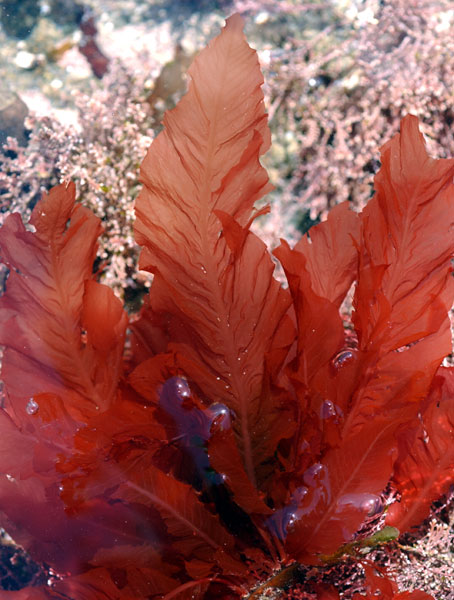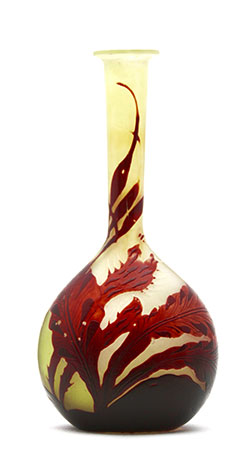Delesseria sanguinea (Hudson) J.V. Lamouroux

Description: Membranous, bright crimson fronds, with cartilaginous, cylindrical, branched stipe arising from a thickened discoid holdfast, to 300 mm long. Branches bearing spirally arranged, leaf-like, ovate-lanceolate blades, each with short stipe and pinnately branched midrib, membranous portion monostromatic, margin undulate (on mature blades), entire. Reproductive structures in small oval, stalked blades, borne on midribs in winter.
Habitat: On rocks, deep shady lower intertidal pools and subtidal, generally distributed, most common and perfectly beautiful in spring.
Similar species: Phycodrys rubens is superfically similar but has a duller brownish-red colour and its leaves have an oak-leaf outline.
Key characteristics: Leaf-like ovate-lanceolate blades.
Eponymy: The genus Delesseria was named for Jules Paul Benjamin Delessert (1773 – 1847), French banker and naturalist.
 Émile Gallé (1846-1904), a French artist who worked in glass, is considered to be one of the major forces in the French Art Nouveau movement. He produced a wonderful series of vases with emphases on naturalism and floral motifs. His early work used clear glass decorated with enamel, but he soon turned to an original style featuring heavy, opaque glass carved or etched with plant motifs, often in two or more colours as cameo glass. An unusual seaweed vase of his is shown on the right.
Émile Gallé (1846-1904), a French artist who worked in glass, is considered to be one of the major forces in the French Art Nouveau movement. He produced a wonderful series of vases with emphases on naturalism and floral motifs. His early work used clear glass decorated with enamel, but he soon turned to an original style featuring heavy, opaque glass carved or etched with plant motifs, often in two or more colours as cameo glass. An unusual seaweed vase of his is shown on the right.
Some of the motifs are clearly based upon Delesseria sanguinea, perhaps a drift plant or even a herbarium specimen. The other plant represented is less clear, but may be Calliblepharis ciliata. The swollen structures on the neck of the vase could be cystocarps of either species.
I am very grateful to a collector of Gallé's vases who brought this wonderful object to my attention.
Species list





